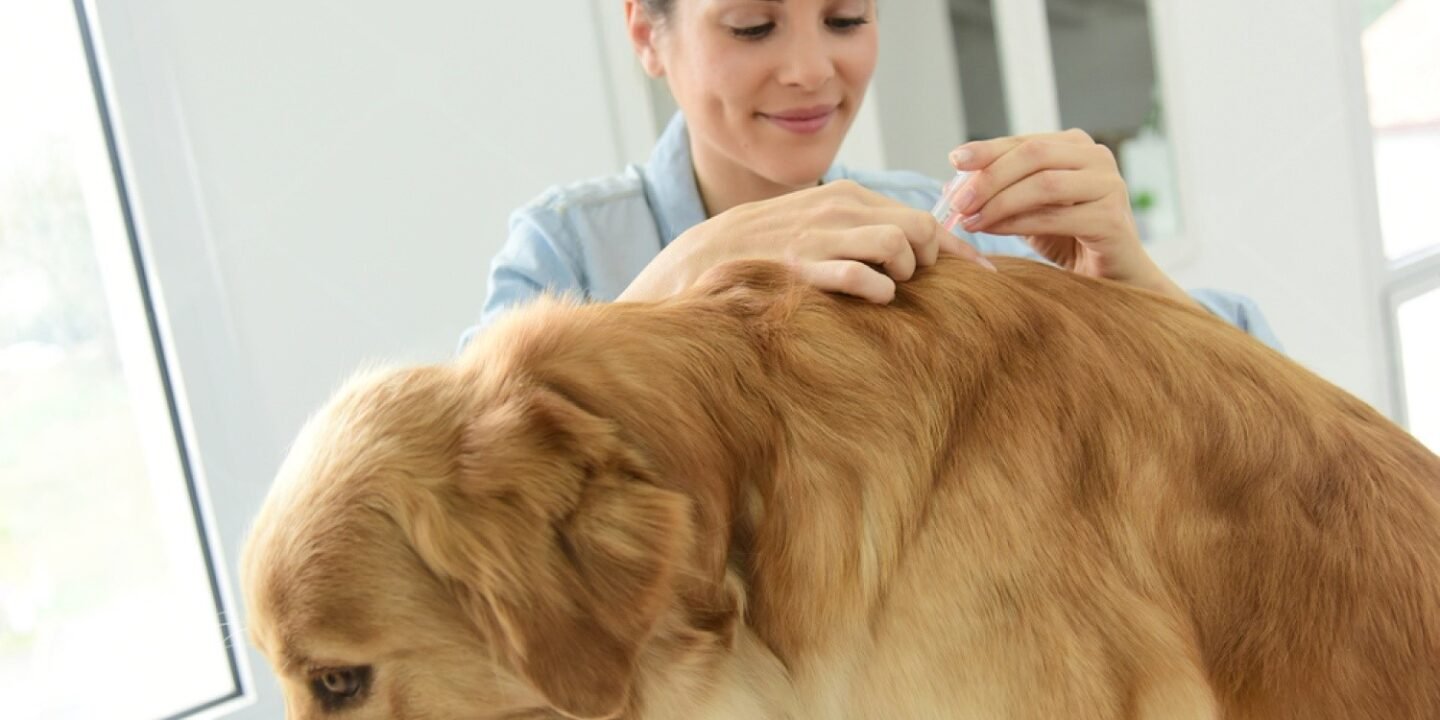Flea treatment for dogs is not just about stopping the itch — it’s essential for preventing dangerous health risks like anemia, tapeworm infection, and persistent dermatitis. Fleas remain the most common external parasite in dogs, capable of thriving year-round and feeding not only on pets but also on humans, while carrying diseases between hosts.
According to a comprehensive veterinary survey, an overwhelming 97% of veterinarians in the U.S. recommend year-round flea protection, recognizing that prevention is far more effective and cost-efficient than emergency treatment. Considering that over one-third of dogs were found to be infested in a recent prevalence study, the urgency of consistent, vet-approved flea control cannot be overstated.
Immediate Actions: First 24–48 Hours
When you first confirm fleas on your dog, acting quickly within the first 24–48 hours can prevent a small issue from becoming a full-blown household infestation.
The first step is to manually reduce the flea load. Use a fine-toothed flea comb around the neck, base of the tail, and groin—these are favorite hiding spots. Drop any fleas you catch directly into soapy water to ensure they don’t jump back onto your dog.
Next, introduce a fast-acting treatment. Both oral and topical veterinary-prescribed options are designed to kill fleas within hours. Dr. Richard Meadows, DVM, and parasitology expert at the University of Missouri, emphasizes: “The key to controlling fleas is speed. The faster you kill adult fleas, the less chance they have to reproduce and infest your environment.” This is why delaying treatment even by a few days can make eradication much harder.
If you have multiple pets, consider temporary isolation of the affected dog until all animals in the household are treated. Fleas easily jump between hosts, and skipping even one pet can allow the cycle to continue.
At the same time, wash all bedding, blankets, and soft furnishings your dog uses in hot water, as fleas and eggs can survive for days in fabrics. Vacuum carpets, furniture, and floor cracks thoroughly, then dispose of the vacuum bag or empty the canister outdoors.
📌 Note from a vet’s perspective: Avoid using human shampoos, essential oils, or DIY sprays unless approved by a veterinarian. Some substances, like tea tree oil, can be toxic to dogs even in small amounts. Stick with vet-recommended products for safety and effectiveness.
| Immediate Action (First 24–48 Hours) |
Veterinary Insight |
| Use a flea comb around the neck, tail base, and groin |
“Physical removal helps reduce flea load quickly before medications take effect.” – Dr. Emily Parker, DVM |
| Start fast-acting vet-recommended oral or topical flea treatment |
“Prompt treatment is essential—fleas reproduce within days.” – Merck Veterinary Manual |
| Isolate affected pets if possible |
“Separation prevents fleas from spreading to healthy pets.” – PetMD |
| Wash bedding & soft furnishings in hot water |
“Hot water kills eggs and larvae hiding in fabrics.” – American Veterinary Medical Association |
📌 Note: Never use human medications or DIY remedies on pets without veterinary approval—they can be toxic or ineffective.
Treatment Options Explained
Flea treatment in dogs must be both fast-acting (to provide immediate relief) and preventive (to stop re-infestation). Below are the primary veterinary-approved methods:
A. Topical Treatments
These are liquid medications applied directly between the shoulder blades, where a dog cannot lick. The active ingredient spreads through the skin’s oils to kill fleas on contact.
- Examples: Frontline Plus, Advantage II
- Pros: Easy to apply, provides month-long protection, safe for most dogs.
- Cons: Effectiveness can decrease with frequent bathing or swimming.
Veterinary note: “Topical preventives remain an excellent first-line defense in multi-pet households, but compliance is key—missing doses often leads to reinfestation.” — Dr. Lisa Powell, DVM (University of Minnesota).
B. Oral Flea Medications
Chewables or tablets are absorbed into the bloodstream, killing fleas when they bite.
- Examples: NexGard, Capstar, Simparica
- Pros: Starts killing fleas within hours; unaffected by bathing.
- Cons: Most require a prescription; some dogs may experience mild digestive upset.
Vet tip: Oral medications are ideal for dogs with skin sensitivities or for owners who bathe their pets often.
C. Flea Collars
Collars release low doses of insecticidal compounds that spread across the skin and coat.
- Examples: Seresto, Hartz UltraGuard
- Pros: Long-lasting protection (up to 8 months with Seresto).
- Cons: May not fully control severe infestations; lower-cost brands can be less reliable.
Veterinary perspective: Flea collars work best as part of an integrated plan, not as a sole treatment in high-risk environments.
D. Flea Shampoos
Medicated shampoos kill fleas on contact but do not provide long-term protection. They are mainly supportive care.
- Best Use: Puppies too young for oral/topical meds, or dogs with immediate heavy infestations.
- Follow-up: Always combine with a monthly preventive to avoid recurrence.
Vet guidance: Shampoos relieve itching temporarily but must never replace ongoing flea prevention.
⚠️ Important: No single method works in isolation. Veterinarians often recommend combining treatments—for example, starting with a fast-acting oral medication to eliminate existing fleas, followed by a monthly topical or collar for continued protection.
Environmental Treatment: Stop the Cycle
One of the biggest mistakes pet owners make is only treating the pet but ignoring the environment. According to the American Veterinary Medical Association (AVMA), “For every adult flea you see on your pet, there may be up to 100 immature fleas hiding in your home.” This means your carpets, bedding, and even tiny cracks in the floor can harbor flea eggs and larvae.
Action Plan:
- Vacuum daily (carpets, furniture, and corners) for at least 7–10 days. Dispose of vacuum bags immediately.
- Wash pet bedding, blankets, and soft fabrics in hot water weekly.
- Use veterinary-approved sprays or foggers to target flea eggs and larvae in the environment.
- Maintain cleaning for 4 weeks, since flea eggs can hatch later even after treatment.
Vet’s Note: Environmental treatment is not optional—it’s a critical step to break the flea life cycle. Skipping this can undo all your efforts on your pet.
Treating All Pets in the Household
Fleas don’t discriminate—if one pet has them, all pets are at risk. Even if some pets aren’t scratching, they could still be carrying fleas or eggs.
Action Plan:
- Treat every pet in the household, not just the one showing symptoms.
- Use species-specific products (never apply dog flea treatments on cats, as some ingredients can be toxic).
- Keep all pets on monthly preventives year-round—not just during flea season.
Veterinary Insight: Dr. Deborah Greco, DVM, emphasizes, “Consistency is key—treating only one pet or skipping monthly doses allows the flea cycle to continue in your home.”
Long-Term Prevention After Treatment
Getting rid of fleas once is only half the battle — preventing them from coming back is the real victory. Long-term prevention ensures your pet stays comfortable and your home remains flea-free.
- Year-Round Protection – Use vet-recommended flea preventatives consistently, even in colder months, since fleas can survive indoors year-round.
- Ongoing Monitoring – Watch for subtle signs like scratching, licking, or red skin patches that may signal a new infestation.
- Regular Grooming – Weekly grooming with a flea comb helps catch early signs and keeps your pet’s coat healthy.
- Home & Yard Maintenance – Keep your yard clear of leaf litter, tall grass, and wildlife access points. A tidy environment reduces flea hiding spots.
When Treatment Doesn’t Work
Sometimes, despite doing everything right, fleas seem impossible to eliminate. Here’s why that might happen and what you can do:
- Resistant Fleas – Certain flea populations may no longer respond to a specific product, requiring a switch in treatment.
- Improper Use – Missing doses, applying treatments incorrectly, or washing pets too soon after application can reduce effectiveness.
- Re-Infestation Sources – Untreated pets, wildlife, or even visiting animals can bring fleas back into your home.
When to Call the Vet:
If fleas persist after several treatment cycles, consult your veterinarian. They can:
- Recommend alternative or combined medications
- Tailor treatment to your pet’s age, health, and lifestyle
- Help identify hidden sources of infestation
Natural Remedies: What Works and What Doesn’t
Many pet parents want to avoid harsh chemicals, but when it comes to fleas, not all “natural” options are safe or effective. While some remedies can help support a flea control plan, they should never replace vet-approved treatments.
- Apple Cider Vinegar (ACV):
Often suggested as a flea spray, but ACV does not kill fleas. At best, it makes your dog’s coat less appealing to them. Think of it as a mild deterrent, not a solution.
- Diatomaceous Earth (DE):
Food-grade DE can be effective against flea larvae in carpets and cracks by dehydrating them. However, it must be used sparingly and safely—inhaling DE dust can irritate pets’ lungs and skin.
- Essential Oils:
While some oils (like cedar or lavender) are promoted for fleas, many—especially tea tree oil, pennyroyal, and eucalyptus—are toxic to dogs and cats. If you want to try essential oils, do so only under veterinary supervision.
Bottom line: Natural remedies can be a helpful add-on, but are not powerful enough to stop an infestation. For your pet’s safety, always pair them with proven flea medications.
FAQ’s
How long does it take to eliminate fleas completely?
With consistent treatment and environmental cleaning, most infestations are controlled in 4–6 weeks. However, since flea eggs can survive for weeks in carpets and cracks, you must continue cleaning and using preventatives during this period.
Are flea medications safe for puppies or senior dogs?
Yes—but only age- and weight-appropriate products. For example, some spot-on treatments are safe for puppies as young as 8 weeks, while others aren’t. Senior pets may need gentler options due to liver or kidney concerns. Always confirm with your vet before applying anything.
Will fleas go away without treatment?
Unfortunately, no. Fleas reproduce at lightning speed—a single female flea can lay up to 50 eggs per day. Without proper treatment, the infestation will grow rapidly, leading to severe itching, skin infections, and even anemia in small dogs.
👉 Read our full guide on flea diagnosis and early signs if you’re unsure whether your dog has fleas.





